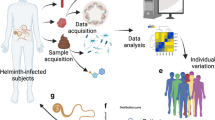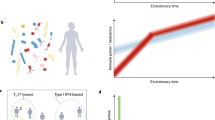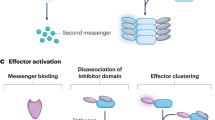Abstract
Humans and the many parasites that we can host have co-evolved over millions of years. This has been compared to an arms race in which the immune armoury of the human has evolved to deal with potential pathogens and the pathogen has evolved strategies to evade, and in some cases use, the immune system of the human host. Recently, there have been marked changes in the exposure of individuals in the developed world to both microorganisms and metazoan parasites, so the immune stimuli such organisms provide no longer have a role in our lives. As we discuss here, this is a marked perturbation, and the absence of the associated immunomodulation might have led to the increased emergence of autoimmune diseases.
This is a preview of subscription content, access via your institution
Access options
Subscribe to this journal
Receive 12 print issues and online access
$209.00 per year
only $17.42 per issue
Buy this article
- Purchase on Springer Link
- Instant access to full article PDF
Prices may be subject to local taxes which are calculated during checkout



Similar content being viewed by others
References
Aaltonen, J. & Bjorses, P. Cloning of the APECED gene provides new insight into human autoimmunity. Ann. Med. 31, 111–116 (1999).
Hyttinen, V., Kaprio, J., Kinnunen, L., Koskenvuo, M. & Tuomilehto, J. Genetic liability of type 1 diabetes and the onset age among 22,650 young Finnish twin pairs: a nationwide follow-up study. Diabetes 52, 1052–1055 (2003).
Banting, F. G. & Best, C. H. The internal secretion of the pancreas. J. Lab. Clin. Med. 7, 465–480 (1922).
Strachan, D. P. Hay fever, hygiene, and household size. BMJ 299, 1259–1260 (1989).
Jaeckel, E., Manns, M. & von Herrath, M. Viruses and diabetes. Ann. NY Acad. Sci. 958, 7–25 (2002).
Goncalves, M. L., Araujo, A. & Ferreira, L. F. Human intestinal parasites in the past: new findings and a review. Mem. Inst. Oswaldo Cruz 98, 103–118 (2003).
Basch, P. F. Schistosomes: Development, Reproduction, and Host Relations (Oxford Univ. Press, New York, 1991).
Woolhouse, M. E. J., Webster, J. P., Domingo, E., Charlesworth, E. B. & Levin, B. R. Biological and biomedical implications of the co-evolution of pathogens and their hosts. Nature Genet. 32, 569–577 (2002).
Pearce, E. J. & MacDonald, A. S. The immunobiology of schistosomiasis. Nature Rev. Immunol. 2, 499–511 (2002).
Sturrock, R. F. in Human Schistosomiasis (eds Jordan, P., Webbe, G. & Sturrock, R. F.) 1–32 (CAB International, Wallingford, 1993).
Webster, J. P. & Woolhouse, M. E. J. Heritability and strain specificity in compatibility between snail intermediate hosts and their parasitic schistosomes. Evolution 52, 1627–1634 (1998).
Dissous, C., Torpier, G., Duvaux-Miret, O. & Capron, A. Structural homology of tropomyosins from the human trematode Schistosoma mansoni and its intermediate host Biomphalaria glabrata. Mol. Biochem. Parasitol. 43, 245–255 (1990).
Duvaux-Miret, D., Stefano, G. B., Smith, E. M., Mallozzi, L. A. & Capron A. Proopiomelanocortin-derived peptides as tools of immune evasion for the human trematode Schistosoma mansoni. Acta Biol. Hung. 43, 281–286 (1992).
Chabasse, D., Bertrand, G., Leroux, J. P., Gauthey, N. & Hocquet, P. Developmental bilharziasis caused by Schistosoma mansoni discovered 37 years after infestation. Bull. Soc. Pathol. Exot. Filiales 78, 643–647 (1985) (in French).
Pearce, E. J. & Sher, A. Mechanisms of immune evasion in schistosomiasis. Contrib. Microbiol. Immunol. 8, 219–232 (1987).
Damian, R. T. Molecular mimicry: parasite evasion and host defense. Curr. Top. Microbiol. Immunol. 145, 101–115 (1989).
Maizels, R. M., Bundy, D. A., Selkirk, M. E., Smith, D. F. & Anderson, R. M. Immunological modulation and evasion by helminth parasites in human populations. Nature 365, 797–805 (1993).
Carvalho-Queiroz, C. et al. Cross-reactivity of Schistosoma mansoni cytosolic superoxide dismutase, a protective vaccine candidate, with host superoxide dismutase and identification of parasite-specific B epitopes. Infect. Immun. 72, 2635–2647 (2004).
Doenhoff, M. J. A role for granulomatous inflammation in the transmission of infectious disease: schistosomiasis and tuberculosis. Parasitology 115, S113–S125 (1977).
Fallon, P. G. & Dunne, D. W. Tolerization of mice to Schistosoma mansoni egg antigens causes elevated type 1 and diminished type 2 cytokine responses and increased mortality in acute infection. J. Immunol. 162, 4122–4132 (1999).
Karanja, D. M., Colley, D. G., Nahlen, B. L., Ouma, J. H. & Secor, W. E. Studies on schistosomiasis in western Kenya: I. Evidence for immune-facilitated excretion of schistosome eggs from patients with Schistosoma mansoni and human immunodeficiency virus coinfections. Am. J. Trop. Med. Hyg. 56, 515–521 (1997).
Amiri, P. et al. Tumour necrosis factor α restores granulomas and induces parasite egg-laying in schistosome-infected SCID mice. Nature 356, 565–566 (1992).
Beall, M. J. & Pearce, E. J. Human transforming growth factor-β activates a receptor serine/threonine kinase from the intravascular parasite Schistosoma mansoni. J. Biol. Chem. 276, 31613–31619 (2001).
Davies, S. J., Shoemaker, C. B. & Pearce, E. J. A divergent member of the transforming growth factor receptor family from Schistosoma mansoni is expressed on the parasite surface membrane. J. Biol. Chem. 273, 11234–11240 (1998).
Verjovski-Almeida, S. et al. Transcriptome analysis of the acoelomate human parasite Schistosoma mansoni. Nature Genet. 35, 148–157 (2003).
Hu, W. et al. Evolutionary and biomedical implications of a Schistosoma japonicum complementary DNA resource. Nature Genet. 35, 139–147 (2003).
Grzych, J. M. et al. Egg deposition is the major stimulus for the production of TH2 cytokines in murine schistosomiasis mansoni. J. Immunol. 146, 1322–1327 (1991).
Grogan, J. L., Kremsner, P. G., Deelder, A. M. & Yazdanbakhsh, M. Antigen-specific proliferation and interferon-γ and interleukin-5 production are down-regulated during Schistosoma haematobium infection. J. Infect. Dis. 177, 1433–1437 (1998).
Grogan, J. L., Kremsner, P. G., Deelder, A. M. & Yazdanbakhsh, M. The effect of anti-IL-10 on proliferation and cytokine production in human schistosomiasis: fresh versus cryopreserved cells. Parasite Immunol. 20, 345–349 (1998).
Angeli, V. et al. Role of the parasite-derived prostaglandin D2 in the inhibition of epidermal Langerhans cell migration during schistosomiasis infection. J. Exp. Med. 193, 1135–1147 (2001).
Herve, M. et al. Pivotal roles of the parasite PGD2 synthase and of the host D prostanoid receptor 1 in schistosome immune evasion. Eur. J. Immunol. 33, 2764–2772 (2003).
Zaccone, P. et al. Schistosoma mansoni antigens modulate the activity of the innate immune response and prevent onset of type 1 diabetes. Eur. J. Immunol. 33, 1439–1449 (2003).
MacDonald, A. S., Straw, A. D., Bauman, B. & Pearce, E. J. CD8− dendritic cell activation status plays an integral role in influencing TH2 response development. J. Immunol. 167, 1982–1988 (2001).
Kullberg, M. C., Pearce, E. J., Hieny, S. E., Sher, A. & Berzofsky, J. A. Infection with Schistosoma mansoni alters TH1/TH2 cytokine responses to a non-parasite antigen. J. Immunol. 148, 3264–3270 (1992).
Thomas, P. G. et al. Maturation of dendritic cell 2 phenotype by a helminth glycan uses a Toll-like receptor 4-dependent mechanism. J. Immunol. 171, 5837–5841 (2003).
Okano, M., Satoskar, A. R., Nishizaki, K. & Harn, D. A. Lacto-N-fucopentaose III found on Schistosoma mansoni egg antigens functions as adjuvant for proteins by inducing TH2-type response. J. Immunol. 167, 442–450 (2001).
van Die, I. et al. The dendritic cell-specific C-type lectin DC-SIGN is a receptor for Schistosoma mansoni egg antigens and recognizes the glycan antigen Lewis X. Glycobiology 13, 471–478 (2003).
Faveeuw, C. et al. Schistosome N-glycans containing core α3-fucose and core β2-xylose epitopes are strong inducers of TH2 responses in mice. Eur. J. Immunol. 33, 1271–1281 (2003).
Kane, C. M. et al. Helminth antigens modulate TLR-initiated dendritic cell activation. J. Immunol. 173, 7454–7461 (2004).
Schramm, G. et al. Molecular characterization of an interleukin-4-inducing factor from Schistosoma mansoni eggs. J. Biol. Chem. 278, 18384–18392 (2003).
Sabin, E. A., Kopf, M. A. & Pearce, E. J. Schistosoma mansoni egg-induced early IL-4 production is dependent upon IL-5 and eosinophils. J. Exp. Med. 184, 1871–1878 (1996).
Brown, D. R. et al. β2-Microglobulin-dependent NK1.1+ T cells are not essential for T helper cell 2 immune responses. J. Exp. Med. 184, 1295–1304 (1996).
Herbert, D. R. et al. Alternative macrophage activation is essential for survival during schistosomiasis and downmodulates T helper 1 responses and immunopathology. Immunity 20, 623–635 (2004).
Sher, A., Fiorentino, D., Caspar, P., Pearce, E. & Mosmann, T. Production of IL-10 by CD4+ T lymphocytes correlates with down-regulation of TH1 cytokine synthesis in helminth infection. J. Immunol. 147, 2713–2716 (1991).
Palanivel, V. et al. B-cell outgrowth and ligand-specific production of IL-10 correlate with TH2 dominance in certain parasitic diseases. Exp. Parasitol. 84, 168–177 (1996).
Hesse, M. et al. The pathogenesis of schistosomiasis is controlled by cooperating IL-10-producing innate effector and regulatory T cells. J. Immunol. 172, 3157–3166 (2004).
Mangan, N. E. et al. Helminth infection protects mice from anaphylaxis via IL-10-producing B cells. J. Immunol. 173, 6346–6356 (2004).
van der Kleij, D. et al. A novel host–parasite lipid cross-talk. Schistosomal lyso-phosphatidylserine activates Toll-like receptor 2 and affects immune polarization. J. Biol. Chem. 277, 48122–48129 (2002).
McKee, A. S. & Pearce, E. J. CD25+CD4+ cells contribute to TH2 polarization during helminth infection by suppressing TH1 response development. J. Immunol. 173, 1224–1231 (2004).
van den Biggelaar, A. H. et al. Decreased atopy in children infected with Schistosoma haematobium: a role for parasite-induced interleukin-10. Lancet 356, 1723–1727 (2000).
Araujo, M. I. et al. Impaired T helper 2 response to aeroallergen in helminth-infected patients with asthma. J. Infect. Dis. 190, 1797–1803 (2004).
Redpath, S., Ghazal, P. & Gascoigne, N. R. Hijacking and exploitation of IL-10 by intracellular pathogens. Trends Microbiol. 9, 86–92 (2001).
Mahot, S., Sergeant, A., Drouet, E. & Gruffat, H. A novel function for the Epstein–Barr virus transcription factor EB1/Zta: induction of transcription of the hIL-10 gene. J. Gen. Virol. 84, 965–974 (2003).
Peacock, J. W. & Bost, K. L. Murine γ-herpesvirus-68-induced interleukin-10 increases viral burden, but limits virus-induced splenomegaly and leukocytosis. Immunology 104, 109–117 (2001).
Godfrey, D. I. & Kronenberg, M. Going both ways: immune regulation via CD1d-dependent NKT cells. J. Clin. Invest. 114, 1379–1388 (2004).
Pryor, S. C. & Elizee, R. Evidence of opiates and opioid neuropeptides and their immune effects in parasitic invertebrates representing three different phyla: Schistosoma mansoni, Theromyzon tessulatum, Trichinella spiralis. Acta Biol. Hung. 51, 331–341 (2000).
Theus, S. A., Cave, M. D. & Eisenach, K. D. Intracellular macrophage growth rates and cytokine profiles of Mycobacterium tuberculosis strains with different transmission dynamics. J. Infect. Dis. 191, 453–460 (2005).
Koppel, E. A. et al. Identification of the mycobacterial carbohydrate structure that binds the C-type lectins DC-SIGN, L-SIGN and SIGNR1. Immunobiology 209, 117–127 (2004).
Van Valen, L. A new evolutionary law. Evol. Theory 1, 1–30 (1973).
Thomas, F., Poulin, R., Guegan, J. -F., Michalakis, Y. & Renaud, F. Are there pros as well as cons to being parasitized? Parasitol. Today 16, 533–536 (2000).
Maizels, R. M. & Yazdenbakhsh, M. Immune regulation by helminth parasites: cellular and molecular mechanisms. Nature Rev. Immunol. 3, 733–744 (2003).
Cooke, A., Zaccone, P., Raine, T., Phillips, J. M. & Dunne, D. W. Infection andautoimmunity: are we winning the war, only to lose the peace? Trends Parasitol. 20, 316–321 (2004).
Wilson, M. S. & Maizels, R. M. Regulation of allergy and autoimmunity in helminth infection. Clin. Rev. Allergy Immunol. 26, 35–50 (2004).
Elliott, D. E., Summers, R. W. & Weinstock, J. V. Helminths and the modulation of mucosal inflammation. Curr. Opin. Gastroenterol. 21, 51–58 (2005).
Summers, R. W. et al. Trichuris suis seems to be safe and possibly effective in the treatment of inflammatory bowel disease. Am. J. Gastroenterol. 98, 2034–2041 (2003).
Summers, R. W., Elliott, D. E., Urban, J. F., Thompson, R. & Weinstock, J. V. Trichuris suis therapy in Crohn's disease. Gut 54, 87–90 (2005).
Cooke, A. et al. Infection with Schistosoma mansoni prevents insulin dependent diabetes mellitus in non-obese diabetic mice. Parasite Immunol. 21, 169–176 (1999).
La Flamme, A. C., Ruddenklau, K. & Backstrom, B. T. Schistosomiasis decreases central nervous system inflammation and alters the progression of experimental autoimmune encephalomyelitis. Infect. Immun. 71, 4996–5004 (2003).
Nagayama, Y., Watanabe, K., Niwa, M., McLachlan, S. M. & Rapoport, B. Schistosoma mansoni and α-galactosylceramide: prophylactic effect of TH1 immune suppression in a mouse model of Graves' hyperthyroidism. J. Immunol. 173, 2167–2173 (2004).
Sewell, D. et al. Immunomodulation of experimental autoimmune encephalomyelitis by helminth ova immunization. Int. Immunol. 15, 59–69 (2003).
El-Wakil, H. S. et al. Effect of Schistosoma mansoni egg deposition on multiple low doses streptozotocin induced insulin dependent diabetes. J. Egypt Soc. Parasitol. 32, 987–1002 (2002).
Elliott, D. E. et al. Exposure to schistosome eggs protects mice from TNBS-induced colitis. Am. J. Physiol. Gastrointest. Liver Physiol. 284, G385–G391 (2003).
Mattsson, L., Larsson, P., Erlandsson-Harris, H., Klareskog, L. & Harris, R. A. Parasite-mediated down-regulation of collagen-induced arthritis (CIA) in DA rats. Clin. Exp. Immunol. 122, 477–483 (2000).
Baxter, A. G. et al. Mycobacteria precipitate an SLE-like syndrome in diabetes-prone NOD mice. Immunology 83, 227–231 (1994).
Sewell, D. L. et al. Infection with Mycobacterium bovis BCG diverts traffic of myelin oligodendroglial glycoprotein autoantigen-specific T cells away from the central nervous system and ameliorates experimental autoimmune encephalomyelitis. Clin. Diagn. Lab. Immunol. 10, 564–572 (2003).
Bras, A. & Aguas, A. P. Diabetes-prone NOD mice are resistant to Mycobacterium avium and the infection prevents autoimmune disease. Immunology 89, 20–25 (1996).
Costalonga, M., Hodges, J. S. & Herzberg, M. C. Streptococcus sanguis modulates type II collagen-induced arthritis in DBA/1J mice. J. Immunol. 169, 2189–2195 (2002).
Lehmann, D. & Ben-Nun, A. Bacterial agents protect against autoimmune disease. I. Mice pre-exposed to Bordetella pertussis or Mycobacterium tuberculosis are highly refractory to induction of experimental autoimmune encephalomyelitis. J. Autoimmun. 5, 675–690 (1992).
McInnes, I. B. et al. A novel therapeutic approach targeting articular inflammation using the filarial nematode-derived phosphorylcholine-containing glycoprotein ES-62. J. Immunol. 171, 2127–2133 (2003).
Elliott, D. E. et al. Heligmosomoides polygyrus inhibits established colitis in IL-10-deficient mice. Eur. J. Immunol. 34, 2690–2698 (2004).
Khan, W. I. et al. Intestinal nematode infection ameliorates experimental colitis in mice. Infect. Immun. 70, 5931–5937 (2002).
Reardon, C., Sanchez, A., Hogaboam, C. M. & McKay, D. M. Tapeworm infection reduces epithelial ion transport abnormalities in murine dextran sulfate sodium-induced colitis. Infect. Immun. 69, 4417–4423 (2001).
Acknowledgements
We are grateful to the Wellcome Trust (United Kingdom) and Diabetes UK, who have supported our research into the ability of infections to modulate autoimmunity. We thank J. Connor, P. Zaccone, H. Cronin, J. Cooke, S. Efstathiou and T. Raine for discussions and for help in the preparation of this manuscript.
Author information
Authors and Affiliations
Corresponding author
Ethics declarations
Competing interests
The authors declare no competing financial interests.
Related links
Related links
DATABASES
Entrez Gene
Infectious Disease Information
OMIM
FURTHER INFORMATION
Rights and permissions
About this article
Cite this article
Dunne, D., Cooke, A. A worm's eye view of the immune system: consequences for evolution of human autoimmune disease. Nat Rev Immunol 5, 420–426 (2005). https://doi.org/10.1038/nri1601
Issue Date:
DOI: https://doi.org/10.1038/nri1601
This article is cited by
-
Cancerogenic parasites in veterinary medicine: a narrative literature review
Infectious Agents and Cancer (2023)
-
Hepatocyte integrity depends on c-Jun-controlled proliferation in Schistosoma mansoni infected mice
Scientific Reports (2023)
-
Nitric oxide debilitates the neuropathogenic schistosome Trichobilharzia regenti in mice, partly by inhibiting its vital peptidases
Parasites & Vectors (2020)
-
Recombinant Sj16 protein with novel activity alleviates hepatic granulomatous inflammation and fibrosis induced by Schistosoma japonicum associated with M2 macrophages in a mouse model
Parasites & Vectors (2019)
-
Preventive and therapeutic effects of Trichinella spiralis adult extracts on allergic inflammation in an experimental asthma mouse model
Parasites & Vectors (2019)



